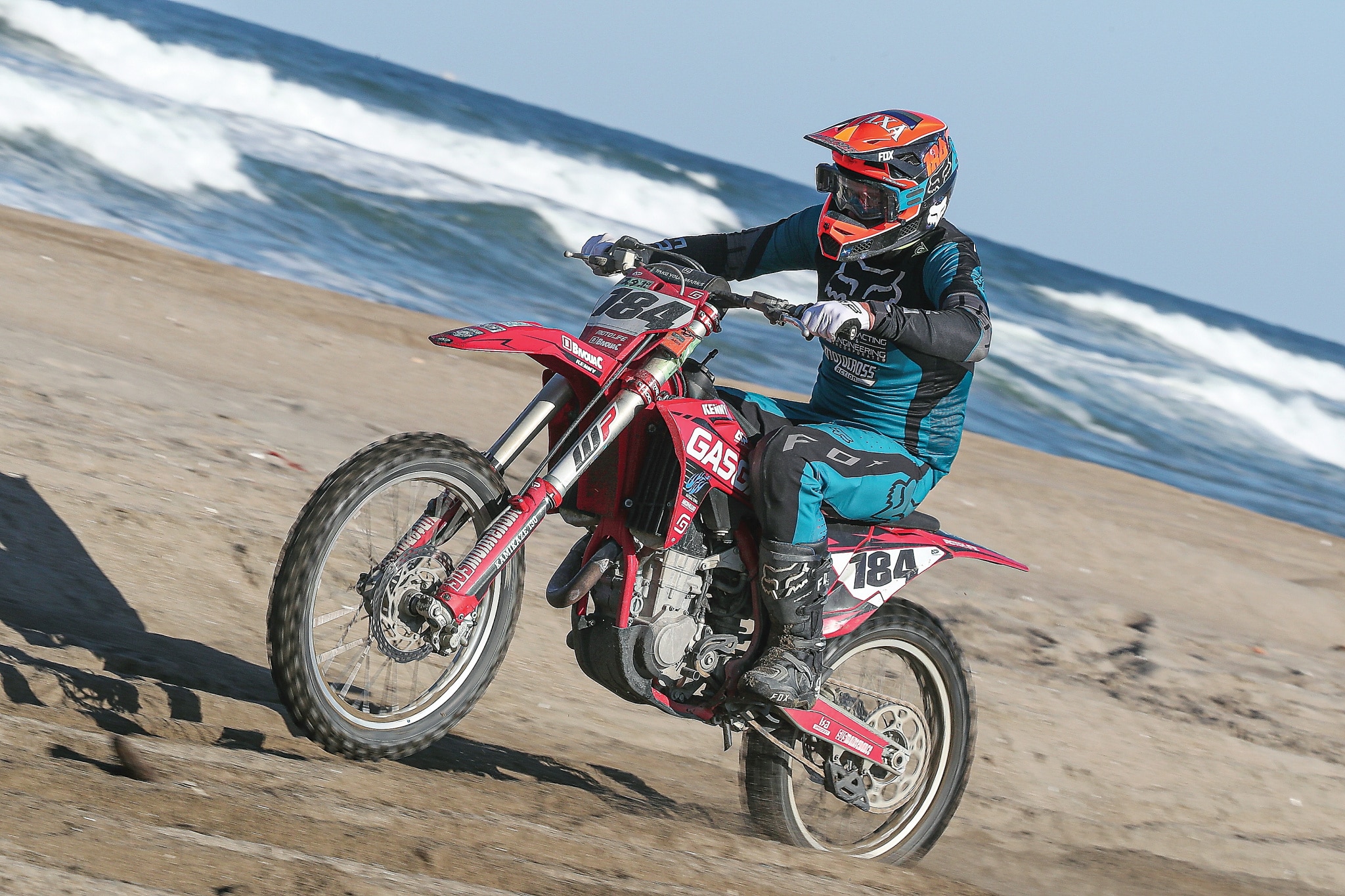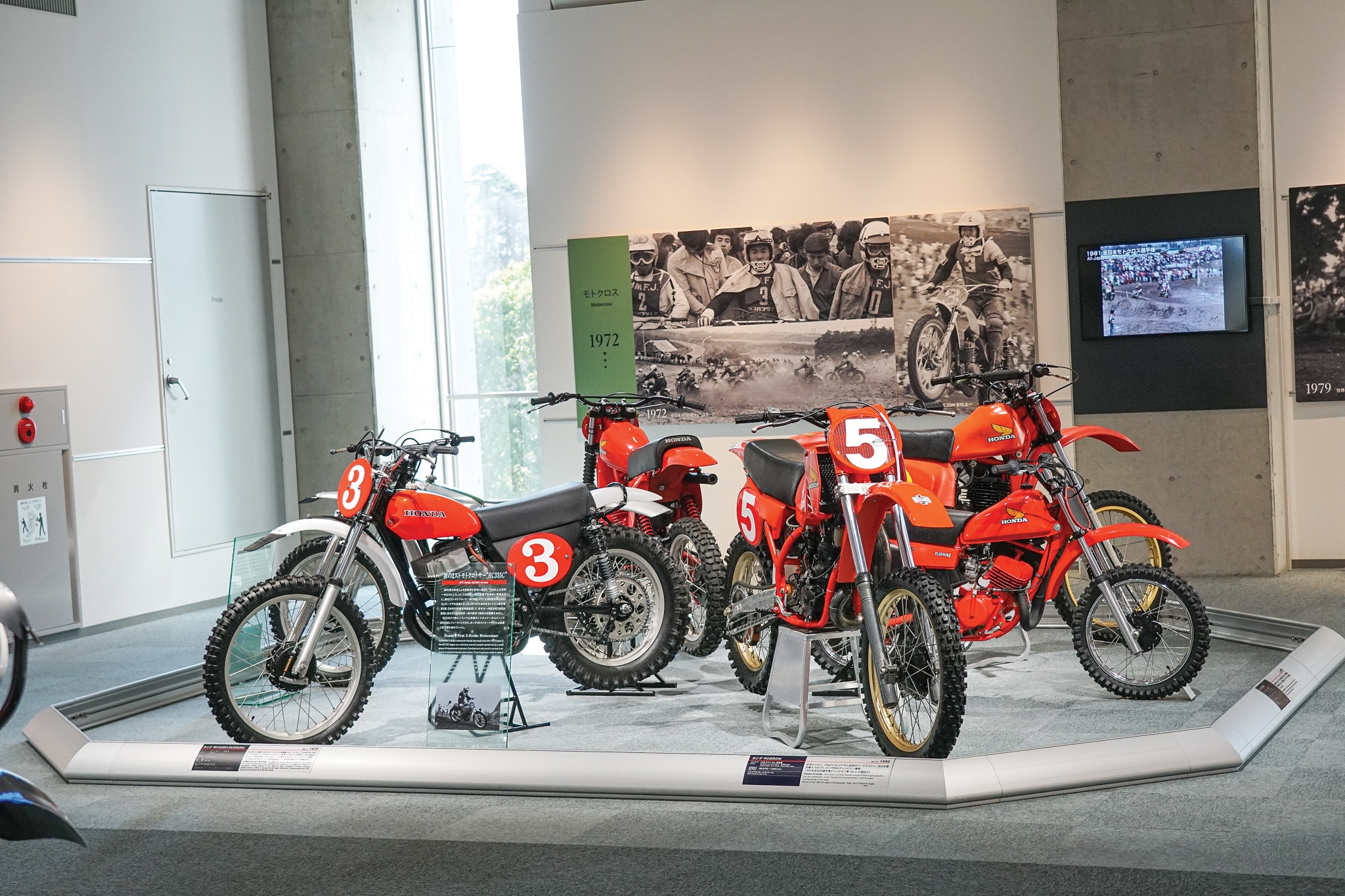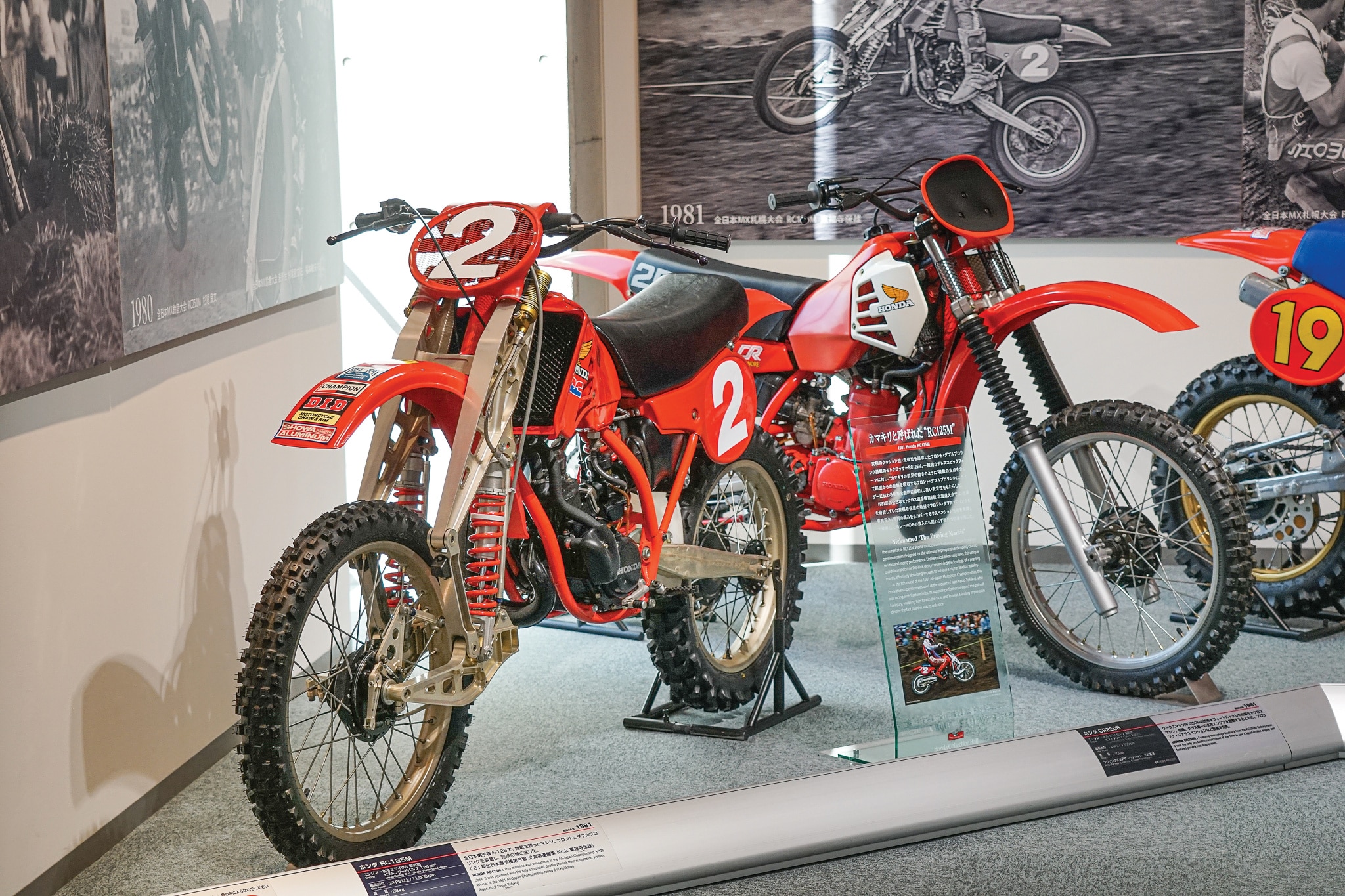THE MXA WRECKING CREW GOES BEACH RACING IN JAPAN

By Dennis Stapleton
Japan is home to the “Big Four” motorcycle manufacturers—Honda, Yamaha, Suzuki and Kawasaki—and numerous motorcycle parts companies, constituting the core of the motorcycle industry. Usually, MXA goes to Japan for new bike releases, to test factory prototypes or to take factory tours. This time, it was a little different, since I have been planning for three years to take a Japanese workcation (a trip that is both work-related and a vacation at the same time). Japan was one of the most restrictive countries to travel to during the COVID pandemic, and Asia as a whole has been off my list of places to travel since March of 2020.
 The Ushiku Amitabha buddha statue in Ibaraki, Japan, was the world’s tallest bronze statue from 1993 to 2008 at 390 feet tall, Dennis went inside and took the elevator to the top.
The Ushiku Amitabha buddha statue in Ibaraki, Japan, was the world’s tallest bronze statue from 1993 to 2008 at 390 feet tall, Dennis went inside and took the elevator to the top.
“MY LAST MXA TRIP TO ASIA WAS TO CHINA FOR WHAT I UNDERSTOOD TO BE AN FIM TEST RACE FOR ONE OF THE TWO PROPOSED CHINESE MXGP EVENTS LATER THAT YEAR. MXA LIKED THE IDEA, AND I JUMPED AT THE CHANCE.”
My last MXA trip to Asia was to Jiangmen Xinhui, China, for an FIM test race for one of the two proposed Chinese MXGP events later that year. It was an all-expenses-paid trip, plus start money, to race in China. MXA liked the idea, and I jumped at the chance. I was chosen because it wouldn’t hurt for the Chinese race promoters to be in MXA, and since I had ridden an FIM test race in Kuwait the year before as a possible landing spot for an MXGP in the future, I seemed like the likely guy to bring to China.
 To fight jet lag after a 12-hour flight, Dennis forced himself to stay up by enjoying the nightlife in the Shinjuku bar district. There are over 100 tiny bars crammed into these brightly lit streets.
To fight jet lag after a 12-hour flight, Dennis forced himself to stay up by enjoying the nightlife in the Shinjuku bar district. There are over 100 tiny bars crammed into these brightly lit streets.
As my flight arrived in Tokyo in the evening, my adventures in Japan began with the Shinjuku nightlife. This was my first time exploring the districts of Kabukicho and Golden Gai. The area was bustling with activity, and the ambiance was unique. I enjoyed my time on these streets, especially when walking in Golden Gai, a neighborhood in the Shinjuku ward of Tokyo that squeezes over 200 miniature bars into a network of narrow alleys. The buildings in Golden Gai are barely a few feet wide and tend to share walls with one another. Most of these bars are so small that they can only seat a maximum of eight people. The vibe here is down to earth, locally minded and still wonderfully strange.
 The street with the world’s smallest bars.
The street with the world’s smallest bars.
“CHERRY BLOSSOMS (AKA SAKURA) ARE A DEFINING SYMBOL OF JAPAN, AND THESE DELICATE PINK FLOWERS BLOOM FOR ONLY A BRIEF PERIOD IN THE SPRING, SO I WAS LUCKY TO GET THE CHANCE TO WITNESS THE SAKURA IN ALL THEIR GLORY.”
After the late-night adventure to shake off jet lag, I started fresh the next morning by visiting the Shinjuku Gyoen National Garden, one of the best-known places to view Japan’s breathtakingly beautiful cherry blossom trees, which just happened to be blooming during my trip. I spent my morning walking around the large garden and soaking up the vibrant spring atmosphere. Cherry blossoms (known as sakura in Japanese) are a defining symbol of Japan, and their blooming is one of the most eagerly awaited natural phenomena in the country. These delicate pink flowers only bloom for a brief period in the spring, so I was lucky to get the chance to witness the sakura in all their glory.
 Dennis took time on day two to visit the Gyoen National Garden, which is one of the best-known places to view Japan’s breathtaking cherry blossom trees.
Dennis took time on day two to visit the Gyoen National Garden, which is one of the best-known places to view Japan’s breathtaking cherry blossom trees.
The following day I headed down a seaside road along the Nikkaw Coast towards the 16th Annual Kamisu City Motorcycle Beach Race. It was raining. As eager as I was to get to the races, I paused to appreciate the unique landscape, with its wide, sandy beaches framed by power-generating windmills and an ocean backdrop.
Adjacent to the beach is a campground used as this event’s venue. For 363 days a year, this is a popular destination for beachgoers and tourists; however, for this one special weekend, the serenity of the beach was replaced by the sweet music of race bikes. The smooth patch of sand had been converted into a racetrack like no other. I had been planning to do this race for years, and I was finally standing on the beach, helmet in hand. Big thanks to my Japanese friends, Eri Takahashi, Kamikaze and Atsushi Genji, who invited me to this race, coordinated the trip, and prepared a GasGas MC450F for me.
This annual event first started in 2011, but was unfortunately postponed during the pandemic. This year’s race was the 16th annual event, with 130 riders divided into two different classes. There would be 15 minutes of practice and two 50-minute races on the 3.5-kiilometer track. After practice, I made a few small changes to the GasGas MC450, like tightening up the steering stem and adding some more air to the WP forks to keep the bike from pitching forward. Right before the start, I went over the plans for our quick pit stop and gave the crew some spare goggles in case I needed them.
“I WANTED TO MOVE CLOSER TO THE WATER WHERE THE SAND WOULD BE FIRMER FROM THE WATER WASHING UP ON IT. ONCE I WEAVED THROUGH TRAFFIC AND HIT THE HARD SAND, I MOVED IN WITH THE LEAD GROUP.”
 Dennis Stapleton (184) leads eventual winner Mashiro Kobayashi (8) through Japanese beach sand that contained some mixed ingredients in the first 50-minute moto.
Dennis Stapleton (184) leads eventual winner Mashiro Kobayashi (8) through Japanese beach sand that contained some mixed ingredients in the first 50-minute moto.
As the riders headed to the starting line, I slowed up to wait for the other riders to select their starting spots, then I went to the line and picked a far-inside position. I did my best to pack down my starting spot to get my momentum rolling when the flag dropped. My start was less than impressive. The first turn was a tight right-hand that led down the first straight next to the water. I wanted to move closer to the water where the sand would be firmer from the water washing up on it. Once I weaved through traffic and hit the hard sand, I moved in with the lead group and tagged along in their draft. That worked well with my strategy to pace myself rather than going all out.
By lap three, the real race had begun, as we started to lap the slower riders and could no longer ride our desired lines. I was in a cat-and-mouse battle with Japanese National Champion Akira Narita. We were passing each other back and forth as we got closer to the halfway point. Behind Narita and me, Mashiro Kobayashi was lurking. He was the only rider in the race with a big gas tank. He didn’t need to make the pit stop that Narita and I were facing on the next lap. I had gapped Akira Narita in traffic and had some breathing room heading for my gas stop.
 Each moto was so long and the beach sand so deep that all the bikes needed to make pit stops at 40 minutes. Here, former Japanese National Champion Isao Ida’s buddies and Dennis’ girlfriend, Alva Yiwei (left), fueled up Dennis’ GasGas MC450F, which was Ida’s spare bike.
Each moto was so long and the beach sand so deep that all the bikes needed to make pit stops at 40 minutes. Here, former Japanese National Champion Isao Ida’s buddies and Dennis’ girlfriend, Alva Yiwei (left), fueled up Dennis’ GasGas MC450F, which was Ida’s spare bike.
While the guys put gas in the bike, my girlfriend shoved some rice balls in my mouth, took my jacket and gave me a gulp of water. When I got back on the track, Mashiro Kobayashi was right behind me as we bobbed and weaved through lapped traffic. Suddenly, Mashiro swooped around the outside of me, carrying more momentum. That gave him the best position going into the chicane section before the finish line. When I looked up, I realized I had just gotten smoked to the checkered flag.
During the break before the second 50-minute moto, the beach race organizer prepared a sushi lunch box for all participants entered in the race. I threw on a new set of gear, only to realize that my 360 camera had come off my helmet and become the property of the Japanese sea. In no time, the whistle blew for the second moto, and I headed back to the starting line, confident that I knew the track and the speed of the guys I was facing.
“WHEN 12-TIME JAPANESE NATIONAL MOTOCROSS CHAMPION AKIRA NARITA TOOK THE LEAD GOING INTO LAP THREE, I KNEW THAT HIS PLAN WAS TO THROW DOWN A FAST LAP TO GAP THE FIELD BEFORE WE HIT THE LAPPERS ON LAP FOUR.”
When the flag flew for moto two, the top-five riders from the first moto were all out front, with Kazumasa Masuda setting the pace for the first two laps. When 12-time Japanese National Motocross Champion Akira Narita took the lead going into lap three, I knew that his plan was to throw down a fast lap to gap the field before we hit the lappers on lap four. The speed picked up as we neared the big push to the pit stop. My moto-two pit stop was much faster than moto one, which was good, because I needed to push hard to catch Akira Narita and to get some kind of gap on Mashiro Kobayashi, who didn’t need to stop for gas. Lapped traffic was terrible, but with two laps to go, I saw Akira Narita getting up off the ground from a crash, but I also saw that Mashiro Kobayashi had the race covered. He went 1-1. I went 2-2, and Akira Narita went 3-3.
After a long day at the races, taking a bath for my sore body sounded like a good idea, so I decided to head to the public bathroom (onsen) in the hotel. I was definitely out of my comfort zone surrounded by seven naked Japanese men, but the bath itself was just what my aching body needed.
“VISITING THE HONDA MOTORCYCLE MUSEUM IS LIKE WALKING AROUND IN A BANK VAULT FILLED WITH JEWELS. THE BIKES ARE A PRESERVED SLICE OF HISTORY.”
 The 1991 Honda RC250MA engine was equipped with an automatic transmission and won the 1991 All-Japan Motocross Championship. Note the backwards kickstarter.
The 1991 Honda RC250MA engine was equipped with an automatic transmission and won the 1991 All-Japan Motocross Championship. Note the backwards kickstarter.
With the beach race behind me and some spare time on my hands, I decided to pay a visit to the Honda Collection Hall, since I’ve always had fun visiting motorcycle factories and museums around the world. The Honda Collection Hall has one of the largest and highest-quality collections of motorcycles in the world. As you would expect from a Japanese company, this Honda museum was orderly and well laid out
 This 1972 Honda RC335 (3) was Honda’s first-ever two-stroke motocross bike. The 1980 All-Japan 250 National Championship was won on this #5 Honda RC250M.
This 1972 Honda RC335 (3) was Honda’s first-ever two-stroke motocross bike. The 1980 All-Japan 250 National Championship was won on this #5 Honda RC250M.
 This 1981 RC125 was unbeatable in the All-Japan 125 Championship. It had the Valentino Ribi-designed Double Pro-Link front suspension system.
This 1981 RC125 was unbeatable in the All-Japan 125 Championship. It had the Valentino Ribi-designed Double Pro-Link front suspension system.
 This 1982 CR250M (19) was the first Honda equipped with the ATAC system that changed the head pipe volume to improve torque and throttle response. Yasuo Tofukuji took it to the 1982 All-Japan Championship.
This 1982 CR250M (19) was the first Honda equipped with the ATAC system that changed the head pipe volume to improve torque and throttle response. Yasuo Tofukuji took it to the 1982 All-Japan Championship.
 This is the bike that Jeremy McGrath won the 1996 AMA Supercross Championship on. It was the fourth of his seven Championships, but his last on Honda.
This is the bike that Jeremy McGrath won the 1996 AMA Supercross Championship on. It was the fourth of his seven Championships, but his last on Honda.
In the Hall, you can get the full Honda experience. The museum contains approximately 300 exhibits, including Honda vehicles, bikes, engines and race cars. The third floor features Honda’s Formula One race machines and many of their FIM World Road Racing Championship bikes. Visiting the Honda motorcycle museum is like walking around in a bank vault filled with jewels. The bikes are a preserved slice of history.
For anyone who is interested in the motorcycle industry, I would recommend taking the time to visit Japan’s motorcycle museums. There is the Honda Collection Hall in the north of Tokyo, Yamaha Communications Plaza and Suzuki Cultural History Museum in Hamamatsu, and the Kawasaki Museum in Kobe. It’s a great way to understand the Japanese motorcycle industry and enjoy the various landscapes while traveling in different regions in Japan.






Comments are closed.